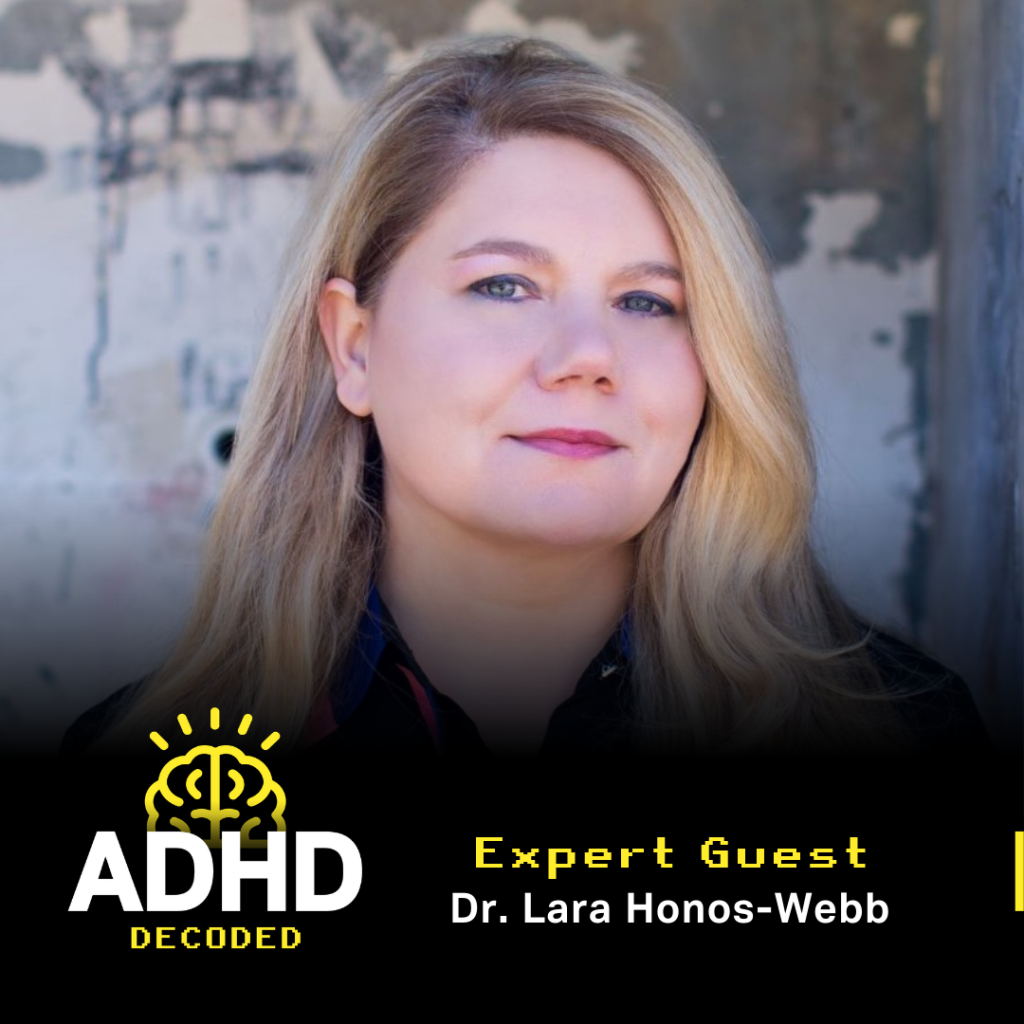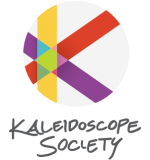In the second episode of ADHD Decoded, Amanda is joined by Dr. Lara Honos-Webb, a clinical psychologist, worldwide ADHD expert, speaker and author, to decode all things involving attention.
Dr. Honos-Webb opens by comparing attention to a flashlight. A flashlight is something that needs to be focused in the right place to fulfill its purpose. In the same way, attention needs to be focused in the right direction. An attention deficit is something that shifts the focus of the attention on to a non-relevant distraction. In order to help someone who may have ADHD focus their attention in the right places, Dr. Honos-Webb recommends adding a number of tools including exercise, managing stress and getting sufficient sleep. Studies also show that understanding one’s own attention limits and knowing when to take strategic breaks is crucial to keeping focused throughout the day.
From here, the conversation shifts to one of the main causes of distraction and anxiety: social media. Dr. Honos-Webb gives a number of helpful tips to help someone who may be struggling with the distracting nature of social media. She recommends looking at social media like scientist, asking how often one finds themself on social media, what the benefits of being on social media are and if that time could be devoted to something more beneficial. The idea is to avoid being mindlessly drawn to the addictive nature of social media and to focus on personal goals. Dr. Honos Webb then unpacks daydreaming and time blindness. For time blindness, she recommends getting a physical planner to plan out the week and account for how much time tasks take. For daydreaming, she recommends focusing it intentionally on goals and plans. Using all these goals and tips can help one cope with and destigmatize having ADHD.
Listen to the episode
Other ways to Listen:
Featured Expert: Dr Lara Honos-Webb

Key Ideas:
- 1:57 – Dr. Honos-Webb explains what attention deficit really means: not being able to pay attention to what one is supposed to be focusing on. ADHD causes a pull towards non-relevant distractions.
- 4:19 – Dr. Honos-Webb recommends looking at the science behind attention to start assembling the tools to keeping attention. This includes exercise, stress management and getting sufficient sleep.
- 6:05 – Amanda and Dr. Honos-Webb unpack the distraction and anxiety inducing nature of technology and social media use.
- 10:03 – Dr. Honos-Webb unpacks time blindness, a common distraction that people with ADHD are accustomed to.
- 15:07 – The two discuss how daydreaming can be a strength when focused intentionally and correctly.
- 17:45 – Amanda recommends water-proof note pads for writing down ideas that start in the shower.
Transcript
Amanda:
Welcome to the ADHD Decoded podcast, your roadmap to understanding the ADHD brain. Here we offer you brain hacks to inspire and empower you to take charge of your life. Whether you are recently diagnosed, have been coping for years, think you might have ADHD or are wanting to learn more about the ADHD brain in general. Then this podcast is for you.
I am your host, Amanda Fischer, and this is brought to you by the Kaleidoscope Society. In this episode, we’re decoding attention and all that comes with it from time blindness, hyper-focus, daydreaming, zoning out, and everything in between. Today we have a special guest joining us, Dr. Lara Honos-Webb. She’s a clinical psychologist, worldwide ADHD expert, speaker and author. She’s authored many books including her most recent ones entitled Six Super Skills for Executive Functioning and BRAIN HACKS.
Dr. Honos-Webb champions a revolutionary approach to ADHD that focuses on leveraging gifts and transforming symptoms into strengths. Learn more about her work at www.ADDisagift.com. So without further ado, it is my pleasure to introduce to you all, Dr. Honos-Webb. So hi Dr. Lara Honos-Webb. Thank you so much for joining us on this episode of Attention Decoded.
Dr. Lara Honos-Webb:
Hi Amanda. I’m so happy to be here and talk with you.
Amanda:
Absolutely. So as a college student with ADHD, sustaining my attention can be really hard if what I have to do for homework doesn’t interest me, or if I have to do something for my job that doesn’t interest me either. So obviously attention issues are at the root of having ADHD. Can you explain to our listeners how attention works in the ADHD brain?
Dr. Lara Honos-Webb:
Mm-hmm (affirmative). Well, one thing I’d like to start off with is the idea that we are always, all of us paying attention while we are awake. And so, when we talk about an attention deficit, the question is really are we paying attention to what we’re supposed to be doing?
Dr. Lara Honos-Webb:
So for example, let’s say you have a paper to write for your class. What you mean by having challenges with ADHD is that it may be hard for me to write my paper. It may be hard for me to get started, but you will be paying attention to something you’re not supposed to be paying attention, and that’s what we call a distraction.
Dr. Lara Honos-Webb:
And so, one of the characteristics of ADHD is being easily distracted and that’s probably a core way of understanding what that deficit disorder means. And I like to think of attention as like a flashlight and it’s something that we have that we want to focus it on where we want to go.
Dr. Lara Honos-Webb:
And with ADHD, there can be this pull towards distractions and things that are not relevant to what we’re doing. The other point that is going to be key to understanding my approach to the gifts of ADHD, since by definition ADHD means attention deficit hyperactivity disorder.
Dr. Lara Honos-Webb:
So we’ve got a deficit and we’ve got a disorder in there. So you might be wondering, “Oh, how do you come up with a gift in that?” And the gift is in part related to this idea that if you look up in the dictionary, what does the word interest mean? And one of the synonyms is attentiveness.
Dr. Lara Honos-Webb:
So there’s going to be this really close connection between paying attention and what we’re interested in. And so, that leads to lots of ideas about how to increase your attention. And there’s also lots of science around how we can increase our attention. But one of the things would be how can I make this more interesting?
Dr. Lara Honos-Webb:
And so, that will be one strategy for looking at and increasing attention. And we can talk a little bit about the science behind. There are things that we know increase attention and there are things that we know decrease attention, that knowing those things gives us a ability to have a growth mindset that there are things we can do again to look for those gifts, find those gifts, and even just to boost our attention.
Amanda:
So what would you say is a practical way for someone with ADHD to increase their ability to pay attention?
Dr. Lara Honos-Webb:
Well, why don’t we start with the science. We know that for example, exercise increases attention and the exercise doesn’t have to be the same thing that gets a person in shape. So for example, one study found that bouncing a ball against a wall for 10 minutes helps some students increase their attention.
Dr. Lara Honos-Webb:
The other thing we have to ask is this big question of what interferes with attention? And we all know that stress is going to interfere with our attention. We’ve all had that experience of having this feeling of this is overwhelming and then we get anxiety, and then anxiety is going to disrupt our attention.
Dr. Lara Honos-Webb:
So stress management is going to be one tool that you can increase your attention and then there’s a whole of course science behind stress management in terms of deep breathing and relaxation. One of the most fundamental of course is going to be getting sleep. Getting low amount of sleep is going to make it very hard for anyone to pay attention.
Dr. Lara Honos-Webb:
And of course, particularly for someone that has ADHD. We also have to think in terms of taking breaks and what I will call attention restoration. And so, for example, there’s a lot of science that a 10 to 20-minute nap can increase attention throughout the day, but also finding out what your focus dose is.
Dr. Lara Honos-Webb:
How long can you pay attention and then do you need to restore your attention? And then coming up with another time of focus. There’s so much research now that nature increases attention because nature itself invites this restoration of attention.
Dr. Lara Honos-Webb:
And then I’ve already talked about how interest is basically the same thing as attention. So how can I make this more interesting or finding a way to game-ify it? And then also this one’s going to be really obvious. It’s going to be a major point for everyone listening is limiting technology.
Dr. Lara Honos-Webb:
We know the technology interferes with our attention. One study showed that if you just had your phone in a purse behind you, you didn’t even have it out, that it diminished a person’s attention just knowing it was there. So that doesn’t even count all of the alerts that you’re getting, all the notifications that you’re getting, which of course are massive distractions.
Amanda:
Wow. So there is really so much that we can do to increase our ability to pay attention. And one of the things you said that resonated with me is limiting technology. That’s something I’ve been trying to do recently is I’ve eliminated social media. It’s for my life, especially during this time with the coronavirus.
Amanda:
There’s just in general a lot of hysteria and just anxiety that comes with interacting with social media. Because I find even when I would use it more, I would tell myself, “Okay, I’m only going to be on there for 20 minutes,” but then 20 minutes would turn into an hour or maybe two hours and I would completely lose track of that.
Amanda:
So what’s a brain hack you could offer our listeners to just navigate that better?
Dr. Lara Honos-Webb:
Well, let’s just do two of them. And so, the first one is going to be very, very simple and it’s going to be sort of mind-blowing when you begin to think about it is ask yourself particularly, let’s say you’re reading news and there’s a lot of stress in the news.
Dr. Lara Honos-Webb:
Ask yourself, “What are the benefits of scanning through alarmist news messages and or in your case, social media?” Because you’ll find the scary stories there too. And so ask yourself, “What are the benefits of this?” And realistically you might be able to say, “Well, it’s important to be informed.”
Dr. Lara Honos-Webb:
But the second technique is to just make being an observer and a scientist and saying, “How many hours a day am I spending on social media?” And it would not be unusual for many people for that number to be three hours. When you notice that three hours, then you could ask yourself this other question, “Which is what are the costs of being on social media or internet browsing the news?”
Dr. Lara Honos-Webb:
And the costs are that it’s going to raise your anxiety, that you’re wasting time, that they’re other things you’re not going to get done. And so, let’s just say for someone out there listening, let’s say that number is three hours. Well, now what I want you to do is ask yourself, “What could I get done in those three hours?”
Dr. Lara Honos-Webb:
And so, now imagine that this is the mind-blowing part. If you took those three hours and you were going to do something else, what would that be? You could get in shape in three hours a day. I mean, you could cook meals from scratch. You could exercise an hour a day, you could read a book on health.
Dr. Lara Honos-Webb:
There’s so many things you could do in that three hours and that three hours a day, you could start up a business idea. You could organize your home. All of those things that you have procrastinated about, you could do in that time. You could use that time for healthy, positive socializing with people connecting.
Dr. Lara Honos-Webb:
One thing people are saying is, “It’s so great to reach out to people I haven’t talked in a long time” or increasing your activities that you have as special interests. I mean, if you’ve always loved painting, this would be a good time to start painting. And so, the idea here is that we sort of mindlessly are drawn to the addictive nature of these technologies.
Dr. Lara Honos-Webb:
And when we say, “What are the benefits of it, what are the costs of it?” And then we say, “Okay, let’s say that number’s three hours. What else could I get done in those three hours?” You could achieve your health goals, your financial goals, your personal goals, your relationship goals.
Amanda:
It lends itself to so many other things and even goal setting. Like what could I be doing with those three hours that I’m spending on social media and how could I be accomplishing my goals in those hours? We’ll save that for another podcast.
Amanda:
I also wanted to get at some of us who’ve been on our ADHD journey for a long time. We’ve heard the term time blindness and for those who have maybe never heard this before, it’s just the idea that sometimes we get so zoned out into one thing that we lose track of time.
Amanda:
So Dr. Honos-Webb, could you explain to our listeners a little bit more about this and what brain hacks you suggest for our listeners to conquer this feast of time blindness?
Dr. Lara Honos-Webb:
Mm-hmm (affirmative). Right, so I mean in part, time blindness is also about unfocus that obviously if you’re unfocused, you’re not paying attention to the time. I think on a deeper level, when we look at ADHD, for the many people, it’s kind of this daydream-y quality and this rich imagination, and we can get lost in our imaginations.
Dr. Lara Honos-Webb:
We can get lost in visual images so we can have a distraction, not only in the real world but in our own minds for ADHD. And the first brain hack I’m going to have is going to seem a little bit too simplistic, but this in my consultation with neuropsychologist has said is pretty essential.
Dr. Lara Honos-Webb:
So the idea is they prescribe a very specific type of calendar, which could be the kind that is a week at a time where you have a whole week laid out in front of you in a book and then each day of the week is broken down into the specific hours. And they ask you to get one of those types of calendars.
Dr. Lara Honos-Webb:
And even if it’s not going to be the main calendar that you use, it needs to be in the real world calendar. I know that we’re going to be using our online scheduling probably as our main way, but this is not necessarily needs to be the calendar that runs your life, but what it does is it’s just a visual exposure to this kind of time grid is going to enhance your sense of time and how you’re spending your hours and how you’re spending your days.
Dr. Lara Honos-Webb:
And if this isn’t going to be your main calendar, for example, if you’re usually doing it online, you can use it to schedule in specific things and just kind of get a sense of what the days of the week are and what the hours of the day are. So that seems really simplistic, like something you would want someone to do in kindergarten.
Dr. Lara Honos-Webb:
But honestly it is what is recommended by neuropsychologist and can be very, very helpful in terms of recognizing how many hours are in the day and when you look at those, you might say, “Wait a minute, if I am spending, I just came up with this right now.” If you’re not going to be using that as your main scheduler, why don’t you use that to write down all the time you’re on social media and you might look at the end of the week, you might look back and be like, “Whoa, that was 25 hours I spent on social media” and all of a sudden you’re directing your attention to how you are spending your time.
Dr. Lara Honos-Webb:
Also, in terms of time blindness is in addition to that would be enhancing your motivation in terms of knowing what your tasks are and you could say, “Oh, I really need to do this paper. It’s due a week from now. I should start today.” Is one of the recommendations I have is when you get an assignment, let’s say you’re in school and this will be different for people in the work.
Dr. Lara Honos-Webb:
When you get an assignment, the first thing you should do is you should just start it when you get the assignment and the reason is because we also have time blindness and saying, “Oh, this will take five minutes or this will take 10 minutes.” But a lot of times you have to familiarize yourself with what exactly does this entail and it may mean that it’s going to be a lot more time than you thought.
Dr. Lara Honos-Webb:
And even if you’re going to say, “You know what? I’m just going to review this assignment so to make sure that I understand it and I can ask questions” and you only do that for five minutes when you get the assignment that’s going to provide an anchor for you to overcome that time blindness.
Amanda:
Wow. Yeah. What I’ve found really helpful, someone with ADHD is having that calendar. I’m 22-years-old, but I’m also a grandma at the same time because I still use a physical planner and I found using that hack of, yeah, having that planner there and having a visual of laying the week out and it’s definitely a tool to hold yourself accountable better and has definitely been a life-changing hack for me for sure.
Amanda:
And I think everyone should have that hack whether they have ADHD or not, but we’re all the more prone to kind of veer off the path and our goals that we set for each other unless we have it written down in a planner, which I found is super helpful.
Dr. Lara Honos-Webb:
You know, just to kind of get in there also with that. It wasn’t meant to at all be like an anti-technology thing. One of the great, wonderful things about our technology today is what I call the executive functioning exoskeleton, which means we can use our technology to in terms of time blindness, like what time do I have to be somewhere or using reminders and prompts, whether it’s Siri, Cortana, or Alexa, that we have these automated personal assistants.
Dr. Lara Honos-Webb:
And so, the time that it would take to invest in learning how to use those personal assistants to give you those reminders, like don’t forget to be here on time and this is due then and having reminders to say this is due in two days.
Dr. Lara Honos-Webb:
Those are going to be some ways to use the technology that is in some many ways disrupting our lives to actually become an exoskeleton. Think of Tony Stark and then think of Iron Man, that Iron Man gives him so much more power. And so too, we can use our technologies for that too.
Amanda:
Yes, absolutely. Another question I have for you, Dr. Honos-Webb is many ADHDers, particularly those with the inattentive subtype, have the tendency to get caught up in their daydreams. How can this tendency to daydream be a strength of someone with ADHD?
Dr. Lara Honos-Webb:
Okay. So there are so many gifts to unfocus and this is really the basis of a lot of my work. And so, what we know is that when you look at the brain structure, the prefrontal cortex is where we get our focus and our attention. And it’s the default mode network, which is this kind of creative daydreaming aspect of ourself.
Dr. Lara Honos-Webb:
And so, with that creativity, with unfocus and daydreaming, it is actually think of daydreaming as creating reality. We have these visual pictures, some people have called a vicarious virtual reality for creating our futures. And I think of that saying for ADHD, we may be building lots of castles in the sky, but we can build those foundations under them.
Dr. Lara Honos-Webb:
It is directly associated with creativity and problem-solving. You can think of yourself as a possibility thinker. This is how we make meaning. And when you look at what is, creativity is kind of a broad word.
Dr. Lara Honos-Webb:
There are four stages to creativity: preparation, incubation, inspiration, and verification. Now the stages of incubation and inspiration are states of unfocus. So by definition, incubation, we might think of a duck sitting on its egg and it’s that you’re just sitting on. It’s kind of like that expression sitting on it. Or we might have the expression, “Oh, I’m going to sleep on it.”
Dr. Lara Honos-Webb:
And what we have realized is that the creativity comes when we turn our attention away from a problem, and then when we come back to it. So that’s what incubation means.
Dr. Lara Honos-Webb:
And inspiration is that moment of aha. And so many people will say, “I get my greatest inspirations in the shower.” And the reason for that is because you’re not focused in the shower. And so those moments of inspiration can come to you after you have spent some time trying to solve that problem.
Dr. Lara Honos-Webb:
So the daydreaming is basically planning. And so, if you think of daydreaming as also, if we can translate that to the next step to setting a goal, what are you doing? You’re planning and planning is one of the major executive functions and is going to help anyone with ADHD is to set those goals because what the goals do? They direct attention.
Amanda:
Wow, there’s so much to unpack there. One thing that you said that totally resonates with me, and I’m sure it will resonate with a lot of our listeners is that daydreaming in the shower happens all the time and I totally get my best ideas whenever I’m in the shower.
Amanda:
And then one hack that I’ve been trying to incorporate into my life is it’s actually an ADHD hack that Kaleidoscope Society has posted on the website and we’ll try to link it in our show notes, but it’s this waterproof, I think there are these waterproof Post-it notes that you can put in the shower.
Amanda:
So when you’re getting those really amazing ideas, you can write it down on this like waterproof, Post-it note, and then you can remember to like put it in your planner and work on it later, plan for it later.
Dr. Lara Honos-Webb:
It’s total genius, that product because it suggests that almost universality of people getting their best ideas in the shower. And the idea is that it is in that state of unfocused. So we have to go to the next question like why does it happen? And it’s because you’re in that state of unfocused, but because you’re not like laying down, you have to navigate standing up and managing the shower that you have as a level of vigilance.
Dr. Lara Honos-Webb:
You’re vigilant, but you’re also relaxed and unfocused. And that is exactly how incubation starts. And so the connection between having a pad of paper you can write on in the shower that’s waterproof is just genius.
Amanda:
Oh my goodness. Well, Dr, Honos-Webb, I would love to keep talking with you more about these topics because there is obviously so much to unpack with them by our time is now coming to a close.
Amanda:
So I just want to thank you so much for dedicating your time and your expertise to helping us with ADHD Decoded so we can give others tools to navigate their ADHD brain. So thank you so much.
Dr. Lara Honos-Webb:
Thank you, Amanda. That was a lot of fun.
Amanda:
Thank you for tuning in to the ADHD Decoded podcast brought to you by the Kaleidoscope Society. Please share it with your family and friends. Together we can dispel stigma and empower each other. Follow @kaleidoscopesociety on Instagram for upcoming podcast postings and join our community at kaleidoscopesociety.com. This is your host, Amanda Fischer. Until next time.




